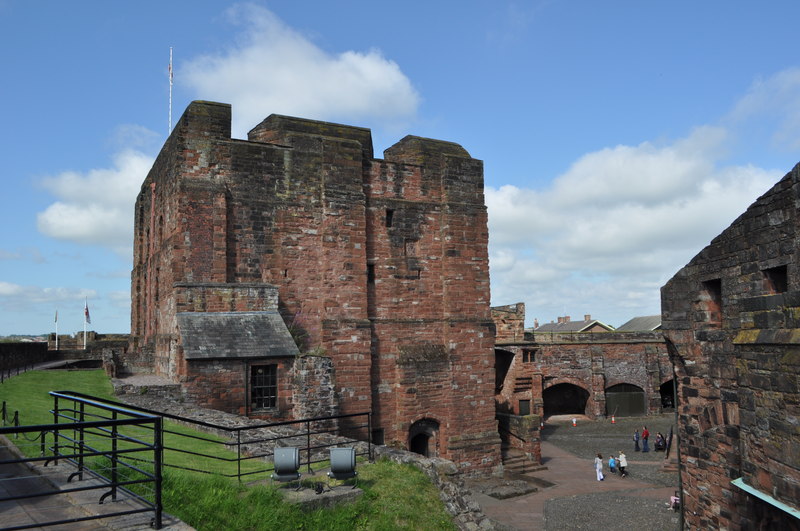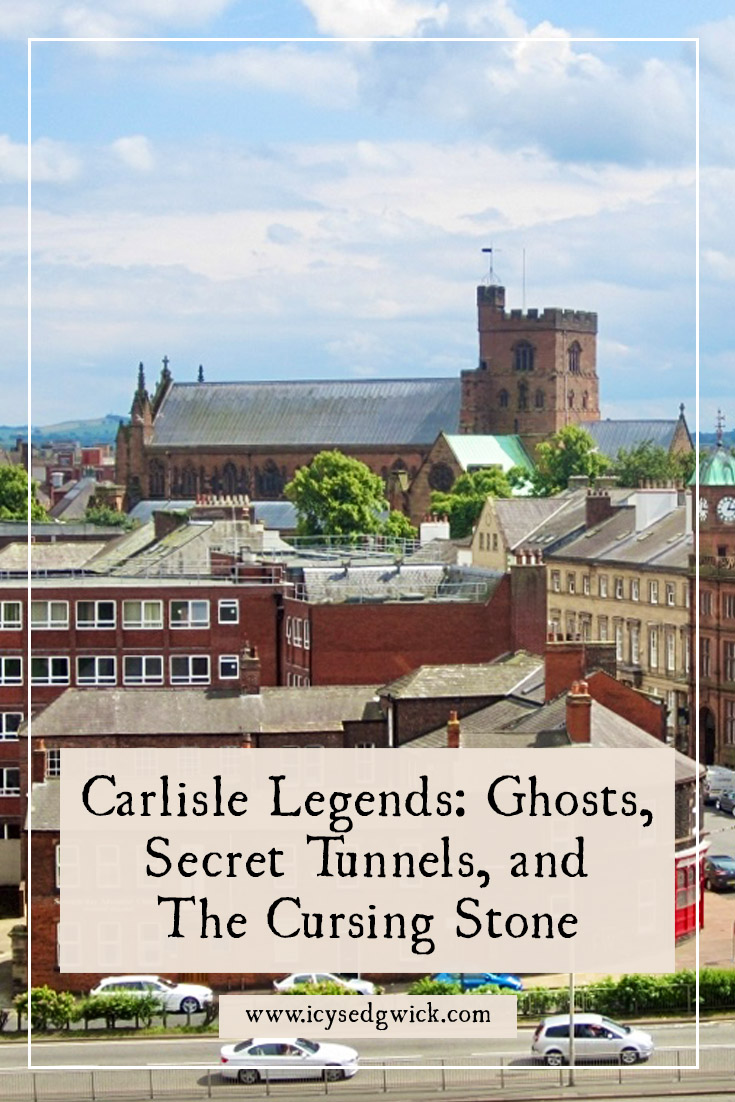Carlisle began life as Luguvalium, a Roman settlement that grew out of the fort on the site. Its next name, Caer Luel (the fortified place belonging to Luel) gives us the beginnings of the name ‘Carlisle’. Vikings captured the town in 876, before the Saxons took it in the 10th century.
Over time, it took on strategic importance for its location near the Scottish border. After all, before 1092, Carlisle was in Scotland. But with so many clashes between the Scots and the English, not to mention the tensions caused by the Border Reivers, it’s safe to say Carlisle has a tumultuous history.
And as I’m sure you’ve noticed by now with these city folklore posts, where a city has history, it has legends. Let’s explore some Carlisle legends, ghost stories, and plain bizarre tales…
The Walled-Up Woman of Carlisle Castle
Carlisle Castle stands on the site of the original Roman fort, supporting garrisons along Hadrian’s Wall. William II took over the site and built the first version of the castle. King David of Scotland took Carlisle in 1135, and built the Keep. Later kings added to the castle over time, made necessary by Carlisle sitting on the Anglo-Scots border. The Scots laid siege to the castle seven times between 1173 and 1461 (English Heritage).
It also became important during the 15th and early 16th centuries, during the breakdown of law along the border, which gave rise to the border reivers. Carlisle Castle was the administrative centre for the West March, the westernmost part of the English border region. The castle was both a prison for border reivers and home to Mary Queen of Scots in 1567.

The Ghost Story
With such a violent history, it’s hardly surprising that construction work turned up a body bricked into a second-floor wall in the keep in 1835. She still wore the tattered remains of a tartan dress and had three rings still on the bones of her fingers (Jones 2024). To this day, no one knows who she was, though people wonder if she was walled up alive.
In 1842, a soldier sat at his post at the castle, passing the time while on guard duty in the early hours of the morning. A spectral woman appeared, drifting towards him. The soldier challenged her; he didn’t know what to make of her, but his duty involved challenging people with no right to be there. She ignored him, so he charged her with his bayonet.
The woman responded by fading before him. The soldier died of shock several hours later (Jones 2024). Most sources draw a line between the discovery of the skeleton and the appearance of the woman, although with seven years between the two, I have to wonder at the lack of other sightings. Although with ghosts, there’s always a possibility she did make other appearances – there was just no one there to see them.
This is the main ghost story recited about the spectre, so it’s unclear if she still stalks the castle, or if no one notices now because no one is there at night.
A Haunted Railway Station
People cite Carlisle Station as a haunted station, though trying to find anything about the ghosts is difficult. Websites all tend to point back to the same brief description in an article from 2010, which I had to look up on Wayback Machine. Three station managers planned to undertake a vigil in the Undercroft, the network of rooms beneath the station (Coleman 2010).

If the Undercroft is haunted, it’s not surprising. The authorities built the station on land reclaimed by clearing slums called ‘the Fever Pit’ in 1847. The station staff went on to use the rooms for a range of uses, including staff accommodation, storage, and even a butcher’s room.
The station managers described the unfriendly atmosphere, explaining that many wouldn’t go into parts of the space. Station manager Sue Howarth described “[r]eports of a headless man on Platform 8, a veiled lady who walks the corridors, the pointing man in the Undercroft and lights on the station that switch on at night” (Coleman 2010).
I tried digging a bit more, and discovered in 2022, Avanti West Coast called in paranormal investigator Louis Davison to find out what was going on beneath the station. According to Davison, staff told him the Undercroft once housed bodies as a makeshift morgue following a train crash near Gretna, that killed over 200 people (Mawson 2022). Davison reported some activity, which might suggest some kind of presence, though it potentially requires further investigation.
In 2017, Kimberley Watkin attempted to turn the Undercroft into a performance and arts venue after local students made use of the space, while plans were also mooted to turn it into a railway museum (Cobb and Bick 2017). I couldn’t find any reports of the students experiencing anything odd, but Watkin’s comment that the space needed proper ventilation does make me wonder if there’s a mundane explanation for the phenomena.
If you’re interested in folklore and ghost stories related to stations, I have an entire bonus episode of Fabulous Folklore, available to Patreon supporters.

Other Hauntings
An old woman apparently haunted a house in the Botcherby area in the 1960s. She lived in a farm cottage at the top of a hill and was famous in the area for always wearing old clothing. While the locals thought her poor, they discovered after she died that she’d hidden £50,000. According to Carlisle legends, her ghost appeared in a house built on the site of the cottage (Paranormal Database 2024).
Also from the mid-twentieth century, people saw a black shape walk through a wall at the Citadel Restaurant before pouring onto the ground (Paranormal Database 2024). I don’t care who you are, that’s just weird.
A spectral cavalier also walks out of a wall on West Walls at dawn, then walks along Abbey Street, onto Paternoster Row, and vanishes when he reaches a set of steps (Paranormal Database 2024). I’ve talked about Civil War ghosts before, and the presence of one in Carlisle reminds us that they don’t only appear at battlefield sites.
The Carlisle Poltergeist
When you think of tales of UK poltergeists, you’ll probably think of Enfield. Maybe Battersea. Possibly Pontefract. But another in the north-west has become part of these Carlisle legends. In September 2007, Allison Marshall and her four children lived on Mardale Road. The events of just a week drove them from the home at 4 am.
Small items started moving across the rooms on their own, while cold spots erupted around the building. They heard a baby crying (the youngest child was three) and inexplicable bangs during the night.
They returned to the house during the day to find doors standing open that had been previously closed, or objects had moved. Allison was too afraid to stay in the house at night.
Both neighbours and Allison’s mother put it down to something paranormal (Daily Mail 2007).
BBC Radio Cumbria’s Emma Borthwick visited the house the same month. After seeing the house was empty aside from the makeshift group of paranormal investigators, Emma reported hearing sounds upstairs. A battery landed beside her out of nowhere, while a spoon appeared on the opposite side of the room. When they went upstairs, they heard footsteps on the stairs and found sunglasses sitting on the staircase (Borthwick 2007).
I can’t find much else beyond this, so I don’t know what happened to the house or the family. Does someone else live there now? Have they experienced anything? Let me know if you know more about it.
The Cursing Stone
In 2001, Carlisle’s Tullie House Museum installed a sculpture designed by Gordon Young and made by Andy Altman. They arranged over 300 words from a 1,069-word-long 16th-century curse on the granite block. The curse references Carlisle’s bloody history with the reivers, working against all manner of criminals, including robbers and highwaymen. Gavin Dunbar, Archbishop of Glasgow, proclaimed the curse in 1525 (BBC 2003). You can read the curse in its entirety here.

Strangely, installing the sculpture seemed to inadvertently curse the city itself. The same year saw a foot-and-mouth outbreak that led to the destruction of infected farm stock. Storm Desmond caused widespread flooding in the city in 2005, factories closed, a boy was murdered in a bakery, and the football team dropped a league (BBC 2006).
Local councillors even proposed destroying or removing the stone, although the financial costs of doing so were less of a priority following the devastation from the floods. You can find the stone in the underpass near the museum.
Is it really a curse, or was it all just a coincidence? You decide…especially since many of the problems seemed to end in 2006. This is definitely one of the more bizarre Carlisle legends.
The Highwayman and the Gibbet
In the 1760s, notorious highwayman John Whitfield was captured and hung in a gibbet for murder on Barrock Hill along the A6. It seems they chose the spot for the gibbet since it lay near the site where the murder took place.
Normally, dead bodies are hung in gibbets, rather than live ones, but according to the legend, locals heard him crying in agony. A coachman apparently passed the gibbet and heard him still moaning a few days later. With little to do to ease Whitfield’s suffering, the coachman shot him to put him out of his misery. According to legend, people still hear Whitfield’s ghost crying for help (Paranormal Database 2024).
It should be noted there’s nothing in the record to say he was put in the gibbet while alive, but it’s interesting that the legend preserves that he was. If anything, the record from St James’ Chronicle notes Whitfield “was executed at Carlisle, and afterwards hung in Chains near the Place where the Fact was committed” (Scott 1899: 95). Funny how folklore often outlives facts.
The Secret Tunnel
It wouldn’t be a city folklore post without a secret tunnel, would it? In Carlisle’s case, the tunnel runs between the Friar’s Tavern and the cathedral.
According to Paranormal Database, people hear knockings and other strange sounds coming from the tunnel, thought to be made by whatever travels between the two points (Paranormal Database 2024).
Yet elsewhere, sources say the passage is only “rumoured” to exist, with the entrance either secret or built over. No one apparently knows where the tunnel comes out, though some think it emerges in the city walls (Murphy 2019).

A review of Carlisle Castle on TripAdvisor even repeated a legend that the tunnel ran between the Castle and the Cathedral so Mary Queen of Scots could go to worship (AdeofWhurch 2013).
It’s probably impossible to say if the tunnel exists at all. Many towns and cities have legends of tunnels, which I’ve covered before. James Wright explores this in more depth in his excellent book Historic Building Mythbusting: Uncovering Folklore, History and Archaeology, but urges us to consider the practicality of building tunnels. How would you keep them secret? Where would you put the spoil from digging the tunnel? How would the tunnel be maintained and ventilated? (2024: 18) Tunnels take a long time to build, and it’s likely builders would only build what was necessary to save on both time and cost.
It’s likely any, or all, of these tunnels remain part of the Carlisle legends.
An Alien Big Cat
I’ve covered alien big cats a few times on the blog, and there’s no shortage of sightings of them in Cumbria. The police got forty reports of sightings between 2003 and 2016 (Ovens 2020).
Yet seeing them in or around cities can sometimes feel like a bit of a surprise.
On 4 August 2012, a man named Raymond Sant apparently spotted an alien big cat. He described the cat as large, black, about the size of a Labrador, but with a long tail. It was near a wooded area near Asda on Chandler Way (Cumberland News 2012).

Given this wooded area is part of the Kingmoor North Nature Reserve, it makes sense that if you were going to see a big cat, it would be somewhere they could hide. I couldn’t find any other reported sightings, either of this animal or one like it, in Carlisle. It is possible that he saw a dog because he admitted he didn’t see its head, but without further sightings, who knows?
Either way, it’s fascinating how many big cat sightings crop up around the country. In a way, the fact we don’t actually come across dead ones makes me think they’re more likely misidentified animals. But they’ve become a part of our folklore, even if no one has definitive proof they’re lurking in the countryside. Or beside Asda.
What do we make of these Carlisle legends?
I think it says a lot that many of the Carlisle legends involve ghosts. Cities, naturally, put humans into close proximity, often over spans of centuries. Carlisle’s age and violent history make it more susceptible than most to stories of hauntings. That these hauntings apparently continue into the 21st century with poltergeist activity is more interesting though. Who is haunting a Carlisle council house, and why?
Yet I think the additional legends, involving the cursing stone, the big cat sighting, and the secret tunnels, speak to a broader interest in the lore of the city. The cursing stone and cat sighting are both 21st-century phenomena, placing them into the contemporary psychic history of Carlisle. And you can’t have a city without secret tunnel stories.
Even if the stories in this article prove to be bunkum, they add a level of interest and fascination to a city on England’s far-flung margins. Like Newcastle upon Tyne, Carlisle butts up against the northernmost reach of the Roman Empire. It survives the Vikings and the Saxons, and it ends up embroiled in Reiver violence. Like my hometown, Carlisle even houses a monarch under arrest. I’d be surprised if Carlisle didn’t have a few legends up its sleeve.
Have you been to Carlisle? Or do you know any other Carlisle legends? Let me know below!
References
AdeofWhurch (2013), ‘We snuck in under the barrier’, TripAdvisor, https://www.tripadvisor.co.uk/ShowUserReviews-g190736-d1753952-r188267304-Carlisle_Castle-Carlisle_Cumbria_England.html .
BBC (2003), ‘The Border Reivers – The Curse’, BBC: Where I live – Cumbria, https://www.bbc.co.uk/cumbria/features/2003/07/restoration/the_curse.shtml .
BBC (2006), ‘Curse of the Cursing Stone’, BBC: Where I live – Cumbria, https://www.bbc.co.uk/cumbria/content/articles/2005/03/02/carlisle_cursing_stone_feature.shtml .
Borthwick, Emma (2007), ‘Chasing ghosts’, BBC Cumbria, https://www.bbc.co.uk/cumbria/content/articles/2007/09/17/poltergeist_feature.shtml .
Coleman, Phil (2010), ‘Trio Plan All-Night Vigil in ‘Haunted’ Rooms Under Carlisle Rail Station’, Cumberland News, https://web.archive.org/web/20150401170318/http://www.cumberlandnews.co.uk/trio-plan-all-night-vigil-in-haunted-rooms-under-carlisle-rail-station-1.762996?referrerPath=home_2_1679 .
Cobb, Matthew and Duncan Bick (2017), ‘Carlisle rail station undercroft could’, Cumberland News, https://www.newsandstar.co.uk/news/16699120.carlisle-rail-station-undercroft-could/ .
Cumberland News (2012), ‘Couple ‘Saw Big Cat’ Near Carlisle’s ASDA Superstore’, Cumberland News, https://web.archive.org/web/20120810122648/http://www.newsandstar.co.uk/news/couple-saw-big-cat-near-carlisle-s-asda-superstore-1.983105?referrerPath=news .
Daily Mail (2007), ‘Family flee home after ‘being attacked by poltergeist throwing glasses”, Daily Mail, https://www.dailymail.co.uk/news/article-481398/Family-flee-home-attacked-poltergeist-throwing-glasses.html .
English Heritage (no date), ‘History of Carlisle Castle’, English Heritage, https://www.english-heritage.org.uk/visit/places/carlisle-castle/history/ .
Jones, Richard (2024), ‘Scottish Lady of Carlisle Castle’, Great Castles, https://great-castles.com/carlisleghost.html .
Mawson, Brandon (2022), ‘Ghost hunter investigates paranormal disturbances in Carlisle’, Cumberland News, https://www.newsandstar.co.uk/news/23173060.ghost-hunter-investigates-paranormal-disturbances-carlisle/ .
Murphy, Stephen (2019), ‘Haunted Carlisle – Tales from the Crypt’, Cumbria Guide, https://cumbriaguide.co.uk/haunted-carlisle-tales-from-the-crypt/ .
Ovens, Ruth (2020), ‘Big cat sightings in Cumbria and the mysterious creatures spotted in the county’, Lancs Live, https://www.lancs.live/news/local-news/big-cat-sightings-cumbria-mysterious-18249856 .
Paranormal Database (2024), ‘Carlisle Ghosts, Folklore and Forteana’, Paranormal Database, https://www.paranormaldatabase.com/hotspots/carlisle.php .
Scott, Daniel (1899), Bygone Cumberland and Westmorland, London: William Andrews & Co.
Wright, James (2024), Historic Building Mythbusting: Uncovering Folklore, History and Archaeology, Cheltenham: The History Press (affiliate link).
Nutty about folklore and want more?
Add your email below and get these posts in your inbox every week.
You'll also get my 5-step guide to protecting your home using folklore!







Have your say!